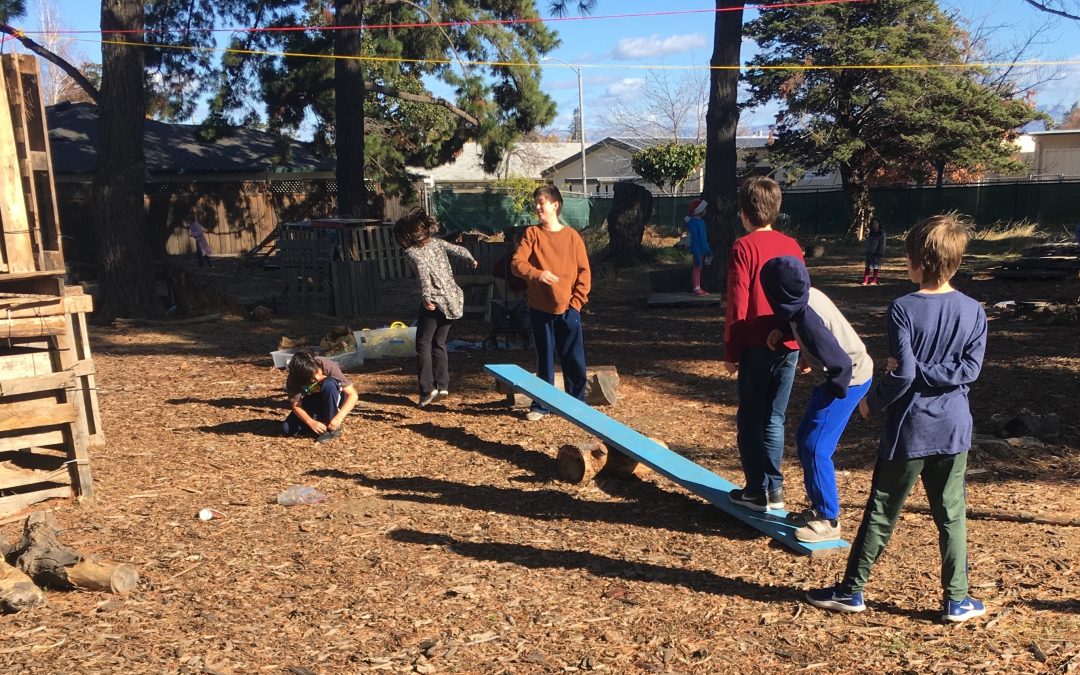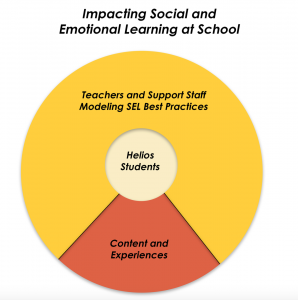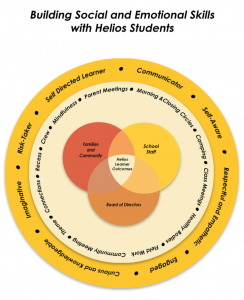By. David DenHartog and Patti Wilczek
Helios New School, located in Sunnyvale, California, is dedicated to high standards around social-emotional learning (SEL) and to integrating SEL into all aspects of the school. Serving 150 K-8 students who have been identified as gifted, Helios provides a project-based, challenging learning environment highlighting academic rigor and social and emotional growth. Recently, the Helios leadership team evaluated methods to strengthen the school’s SEL approach. Comprehensive consideration of all facets where SEL is modeled and/or taught on a daily basis were considered. The result was not a new SEL program but rather a holistic approach that mandates SEL be at the forefront of consideration. Going forth, Helios New School is confident the increased focus and explicit SEL integration will result in advancing student and adult skills and characteristics.
Helios’ Philosophy
At the heart of the Helios approach is an understanding that character is malleable. Just as a person can become a better reader, writer, or mathematician through practice, Helios students can improve on character traits through explicit attention to SEL paired with intentional practice. In addition, Helios staff recognize that they are teaching SEL to students in every action and interaction that happens at school. Undoubtedly, students gain a tremendous amount of SEL insight through modeling outside of school but as educator Haim Ginott profoundly explains, educators possess a tremendous amount of influence. As an educator… “it’s my personal approach that creates the climate. It’s my daily mood that makes the weather.” Helios staff members believe that at least two-thirds of a students’ social and emotional learning comes from modeling, attitude, approach, and interaction. This perception is supported by research from leading practitioners.
Character Experts
In his book, Helping Children Succeed, Paul Tough shares multiple examples of model educators creating learning environments that foster character growth. Most of the time, these admirable instructors do not even mention character traits, but challenge, support, encourage, and question students in a way where SEL is bound to grow. Angela Duckworth, founder of Character Lab and author of Grit: The Power of Passion and Perseverance, offers that effort, which counts “double” if students are to move from talent to achievement, is significantly influenced by interest and autonomy. This stance is supported by research highlighted by Daniel Pink in his book, Drive: The Surprising Truth About What Motivates Us. Pink and multiple human performance researchers identify autonomy, mastery, and purpose as predominate intrinsic motivators. All these leading thinkers, along with the poster child of the “growth mindset” Carol Dweck, confirm the Helios SEL approach in which daily educator decisions are at the forefront of teaching. Fostering a learning environment that is full of challenge and opportunity must be balanced with connecting to student interest and allowing creativity to flourish. SEL is at the heart of this work and integrated throughout the Helios program.
Helios’ SEL Program
While considering multiple SEL touch points, the Helios leadership team identified 18 specific places where attention is critical. These 18 areas are highlighted in the following graphic, found in the inner circle, surrounding the adult influencers. At the heart of the graphic are the Helios Learner Outcomes, the core values from which the mission and vision emerges. On the outside of the circle are outcomes that characterize the holistic approach. Identified areas, such as Mindfulness, Morning and Closing Circles, Parent Meetings, and Fieldwork, are prime SEL teaching opportunities. In each of the identified areas, responsibilities have been defined, resources for instruction collected, and assessment methods established. SEL at Helios New School is integrated broadly with intentionality.
SEL Embedded in Content
Considering Daniel Pink’s recognition of autonomy, mastery, and purpose as high intrinsic motivators, Helios staff facilitate constructivist learning framed thematically through multiple academic disciplines. These semester-long experiences are designed around grade-level standards that include the creation of high-quality projects. Undoubtedly, the depth of these learning experiences offers countless opportunities to integrate SEL development. Previously, Helios staff sporadically considered how SEL intersects with academics; now SEL is at the forefront. While collaborating, researching, and engaging in fieldwork experiences, Helios students’ SEL is strengthened through instructors’ intentionality.
Assessment
It is one thing to plan for more SEL integration and to hope that things improve. It’s another to collect data on development and determine if growth has happened. Just as we do with traditional subjects like reading, writing, and math the Helios team recognizes that collecting SEL data is critical. Not only will this data bring more attention to the topic, but it will help students and adults consider growth. In the academic world, collecting SEL data is recognized as a challenging task and involves elements of subjectivity (as does every other traditional content area). What the Helios staff has committed to is being consistent with assessments by collecting student self-evaluations and adult observations. Using professionally developed questions and a standard process, Helios staff are confident that this new level of data collection will result in a clearer SEL story.
Ensuring Success
Teachers are constantly being asked to do more. The job of a teacher is now so much more than delivering content. Doing a great job of modeling and instructing with SEL at the forefront is an element of teaching that most need and want more support in implementing. Teachers also need time to plan and reflect, both of which are often cited by teachers when considering how to improve their own practice. All these factors led the Helios leadership team to embed additional planning time into next year’s schedule. Helios has also committed to developing an SEL resource bank in which teachers can easily draw from. Lastly, the Helios leadership team is committed to modeling expectations through daily interaction and professional learning collaboration.
Conclusion
No one would disagree that SEL is an important element of any school. What differentiates schools is the level of intentionality to SEL growth and development. Many can share good ideas about SEL but what you see demonstrated, the systems and structures that are in place, tells a different story. Helios New School is doing much more than talking about SEL. The Helios team recognizes the power that SEL offers young people and the important role each adult plays in that development. The following school year will be full of new experiences at Helios, including a renewed, prominent focus on SEL. It’s an exciting opportunity that has the potential to move a good school to great.
Author Bios
David DenHartog is a consummate learner who has been leading education transformation for over two decades. Deeper learning has defined his educational journey, both personally and professionally. David spent over 10 years working with Expeditionary Learning (EL Education) as a Principal and School Designer and continues to advocate for experiential education in his current role as a School Coach for the Green Schools National Network. Energizing schools to further healthy, caring environments and building strong relationships and authentic connections while fostering curiosity and compassion fuel David’s ceaseless commitment to excellence in education and green initiatives.
Patti Wilczek is a life-long seeker of sustainable practices, with more than 20 years working in education. As a new leader at Helios School, she is working closely with staff and students to reduce the school’s carbon footprint, recycle and repurpose materials across the campus, and weave sustainability and green advocacy into the educational program.



